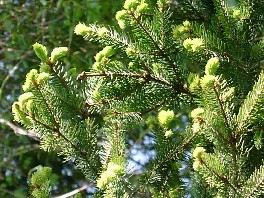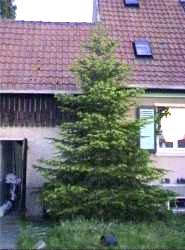 The spruce is a wide-spread tree, that lives in boreal and temperate regions.
Very often it is cultivated because of its wood.
The spruce is a wide-spread tree, that lives in boreal and temperate regions.
Very often it is cultivated because of its wood.
The soft young shoots, that can be recognized from their lighter color, can be used as a herbal remedy.
The main uses of the spruce are problems with the respiratory system, because the essential oils of the spruce desinfect and clean the lung.
Another use of the spruce are problems with the blood supply.
Medicinal Uses
- Stimulating
- Antibacterial
- Calming
- Mucus-dissolvent
- Sudorific
- strengthening
- Bronchitis
- Coughs
- Whooping coughs
- Asthma
- Catarrh of the respiratory system
- Pharyngeal inflammation
- Sinus inflammation
- Rheumatism
- Gout
- Arteriosclerosis
- Nervousness
- Nervous heartproblems
- Neuralgias
- Muscular ache
- Sleeplessness
Information
| Other names: | Common Spruce, Himalayan blue pine, Spruce Fir |
| Used Parts: | Young Sprouts (Tips), Needles, Resin |
| Substances: | Turpentine, Resin, Essential Oil, Vitamin-C |
| Time to collect: | Sprouts: Spring, Needles: June until August, Resin: June until August |
Methods
 The main use of the spruce are diseases of the breathing system,
specially when the problems come from bacterias and sticking mucous.
The main use of the spruce are diseases of the breathing system,
specially when the problems come from bacterias and sticking mucous.
Spruce Tea
With the young shoots or the needles you can prepare an infusion and drink it as a tea.Such a tea can help against cough, asthma and sometimes against pneumonia. You can add honey to this tea to improve the taste and the effect. This tea is also good against the flu to allay the problems of the respiratory organs.
Because of the vitamin C, that can be found in the spruce tips, you can use spruce tea against spring tiredness and other symptoms of lack of vitamin C.
Turpentine
The turpentine contains the essential oil and the resin of spruces, firs and pines.It has a burning effect on the skin and can strengthen the blood supply. In higher doses it can provoke vesicles and inflammations. Therefore it is important to be very careful when using turpentine.
After creaming the skin with a greasy ointment you can aplly turpentine against rheumatic pains of joints and muscles. You need to have a look on the treated areas to prevent from burns.
As an inhalation you can use turpentine against asthma and inectious diseases of the breathing system.
When you put a little bit ot turpentine in a bath you can strengthen the blood supply and therefore provoke the healing of bad healing wounds. A turpentine bath can also allay rheumatic pains and gout.
The internal use of turpentine is difficult, because the kidneys can be affected from this. The effect of internal used turpentine is to kill worms and other parasites and it strengthens the production of digestion juices. Use turpentine internally only when watched by a doctor.
Essential Oil
The essential oil of the spruce can be used similiar like the turpentine.The essential oil can also burn the skin, therefore it should only be used diluted.
You can dilute the essential oil of the spruce with vegetable oil and use it to apply on muscle spasms and pains.
Spruce Tincture
You can make a tincture from the fresh shoots of the spruce. It becomes best if you combine this with juniper berries.
You can apply this tincture against muscle and joint pain.
Internal you can use it against problems of the respiratory system.
Don't overdose the tincture internally to not affect the kidneys.
Plant description
 The spruce can be found in the northern hemisphere in boreal and temperate ares.
In the mountains it grows up to 2000 m.
The spruce is a wide spreaded business tree that is cultivated in a lot of areas.
Forrests that consists only of spruces are in high danger to be destroyed by storms and animals.
The roots of the spruce are not very deep what makes it even more easy for a storm
to overthrow the spruces.
The spruce can be found in the northern hemisphere in boreal and temperate ares.
In the mountains it grows up to 2000 m.
The spruce is a wide spreaded business tree that is cultivated in a lot of areas.
Forrests that consists only of spruces are in high danger to be destroyed by storms and animals.
The roots of the spruce are not very deep what makes it even more easy for a storm
to overthrow the spruces.
The spruce is the most favourite christmas tree, because of its conical form and its fast growing.
The spruce is an evergreen conifer that grows up to 50 m.
The form of the spruce is like a conus.
The needles of the spruce are dark green and grow around the branches. In springtime new sprouts grow at the tip of the branches. In the beginning these sprouts are light green and soft.
In May the spruce blossoms.
Male and female flowers grow on the same tree.
Long hanging cones develop from the female flowers.
Collecting tips
 The young sprouts can be collected in springtime.
The young sprouts can be collected in springtime.
To not disturb the trees to much, collect only sprouts in the lower area of the trees. Only take few sprouts from every tree.
In the summertime you can collect needles and resin of the spruce.
All the parts of the spruce should be collected at dry days, because when wet the needles get stinky rather soon.
Beware!
If you don't have spruces in your own garden
you should ask the owner of the forrest whether you may collect parts of the spruces.
If you don't ask the owner of the forrest will maybe very angry.
